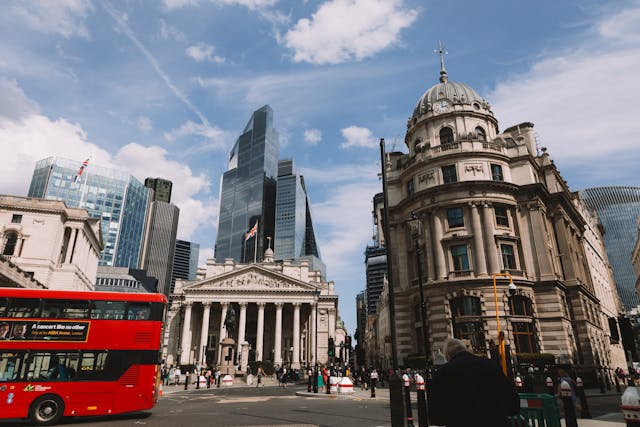The Bank of England and Royal Exchange
Pillars of London’s Financial Legacy
At the heart of the City of London, where centuries of financial history converge with modern economic power, stand two iconic institutions: the Bank of England and the Royal Exchange. These architectural marvels not only dominate the cityscape but also embody the very essence of London’s enduring status as a global financial hub. Their stories intertwine with the economic and social fabric of Britain, offering visitors a glimpse into the forces that have shaped the nation’s prosperity and influence on the world stage.
The Bank of England, often referred to as the “Old Lady of Threadneedle Street,” is a testament to both architectural grandeur and financial stability. Founded in 1694 to act as the English government’s banker, it has since evolved into one of the world’s oldest central banks and a crucial pillar of the UK’s monetary system. The current building, designed by Sir John Soane in the early 19th century, exudes an aura of solidity and permanence befitting its role.
As you approach the Bank, you’re immediately struck by its imposing façade. The structure’s most intriguing feature is perhaps its windowless outer wall, a design choice that speaks volumes about the institution’s priorities. This architectural quirk, implemented for security reasons, gives the building a fortress-like appearance, silently conveying the immense value and sensitive nature of its contents. The wall’s blank face serves as a physical manifestation of the Bank’s commitment to safeguarding the nation’s financial interests.
Just a stone’s throw away stands the Royal Exchange, a building steeped in commercial history and architectural splendor. Originally established in the 16th century by Sir Thomas Gresham, the Royal Exchange has been at the center of London’s trading activities for centuries. The current building, the third on this site, dates back to 1844 and showcases a magnificent neoclassical design that continues to captivate visitors and passersby alike.
The Royal Exchange’s portico, with its eight towering Corinthian columns, creates a grand entrance that befits its historical significance. These columns, each a masterpiece of craftsmanship, support a triangular pediment adorned with intricate sculptures, telling the story of commerce through the ages. As you stand before this façade, you’re transported back to an era when merchants and financiers would gather here to conduct business that would shape empires.
Atop the building, keen-eyed observers will spot a curious detail – a golden grasshopper weathervane. This isn’t merely a decorative element; it’s a symbol rich in meaning, harking back to the Royal Exchange’s founder, Sir Thomas Gresham. The grasshopper, taken from Gresham’s family crest, has become an enduring emblem of the institution, a reminder of its origins and the entrepreneurial spirit that has driven London’s commercial success for centuries.
In front of the Royal Exchange stands a statue that adds another layer to the area’s historical narrative – the Duke of Wellington astride his horse. This monument to one of Britain’s most celebrated military leaders serves as a poignant reminder of the interconnectedness of military prowess and economic might in shaping the nation’s destiny.
Today, while the Bank of England continues its crucial role in managing the UK’s monetary policy and maintaining financial stability, the Royal Exchange has undergone a transformation. Its grand interior, once filled with the clamor of traders, now houses an array of luxury shops and high-end restaurants. This evolution mirrors London’s own journey, adapting to changing times while maintaining a deep connection to its historical roots.
Together, these two institutions create a powerful visual and symbolic representation of London’s financial district. They stand as testaments to the city’s resilience, adaptability, and enduring global influence. The Bank of England, with its air of mystery and authority, continues to steer the nation’s economic course. Meanwhile, the Royal Exchange, having reinvented itself for the modern era, embodies the spirit of innovation that keeps London at the forefront of global commerce.
As you explore this area, take a moment to absorb the atmosphere. The blend of historical gravitas and contemporary dynamism is palpable. From the silent strength of the Bank’s windowless walls to the bustling luxury within the Royal Exchange, every aspect tells a story of a city that has, for centuries, been a crucible of financial innovation and economic power.
Whether you’re an architecture enthusiast, a history buff, or simply curious about the forces that shape our world, the Bank of England and Royal Exchange offer a unique window into the heart of London’s financial legacy. They stand not just as beautiful buildings or historical curiosities, but as living symbols of the economic engine that has driven London’s growth and influence for generations.

